Employment-Based Project Proposal: Physical Activity and Health
VerifiedAdded on 2022/08/19
|34
|8796
|12
Project
AI Summary
This project proposal outlines a mixed-methods study designed to assess the effectiveness of exercise and non-exercise based physical activity interventions in reducing workplace sitting time and improving health outcomes among employees. The project aims to evaluate changes in body mass index, blood sugar, and blood pressure. The proposal is motivated by the high prevalence of obesity and cardiovascular disease in the UK, and the established link between sedentary work environments and poor health. Participants from a local organization with sedentary occupations will be randomized into control and experimental groups. The experimental group will receive physical activity interventions. Data collection will include anthropometric measurements, metabolic assessments, and interviews. The study will review current evidence-based research to develop effective physical activity guidelines for preventing adverse health outcomes in the workplace. The proposal includes a literature review, detailed methodology, ethical considerations, and expected findings. This study intends to contribute valuable insights into strategies for promoting employee health and well-being through workplace physical activity initiatives.

EMPLOYMENT BASED PROJECT PROPOSAL
NDILIPOMWENE SHEEKULI
40339956
EXPLORING EVIDENCE TO IMPROVE PRACTICE
NMS111174
NDILIPOMWENE SHEEKULI
40339956
EXPLORING EVIDENCE TO IMPROVE PRACTICE
NMS111174
Paraphrase This Document
Need a fresh take? Get an instant paraphrase of this document with our AI Paraphraser
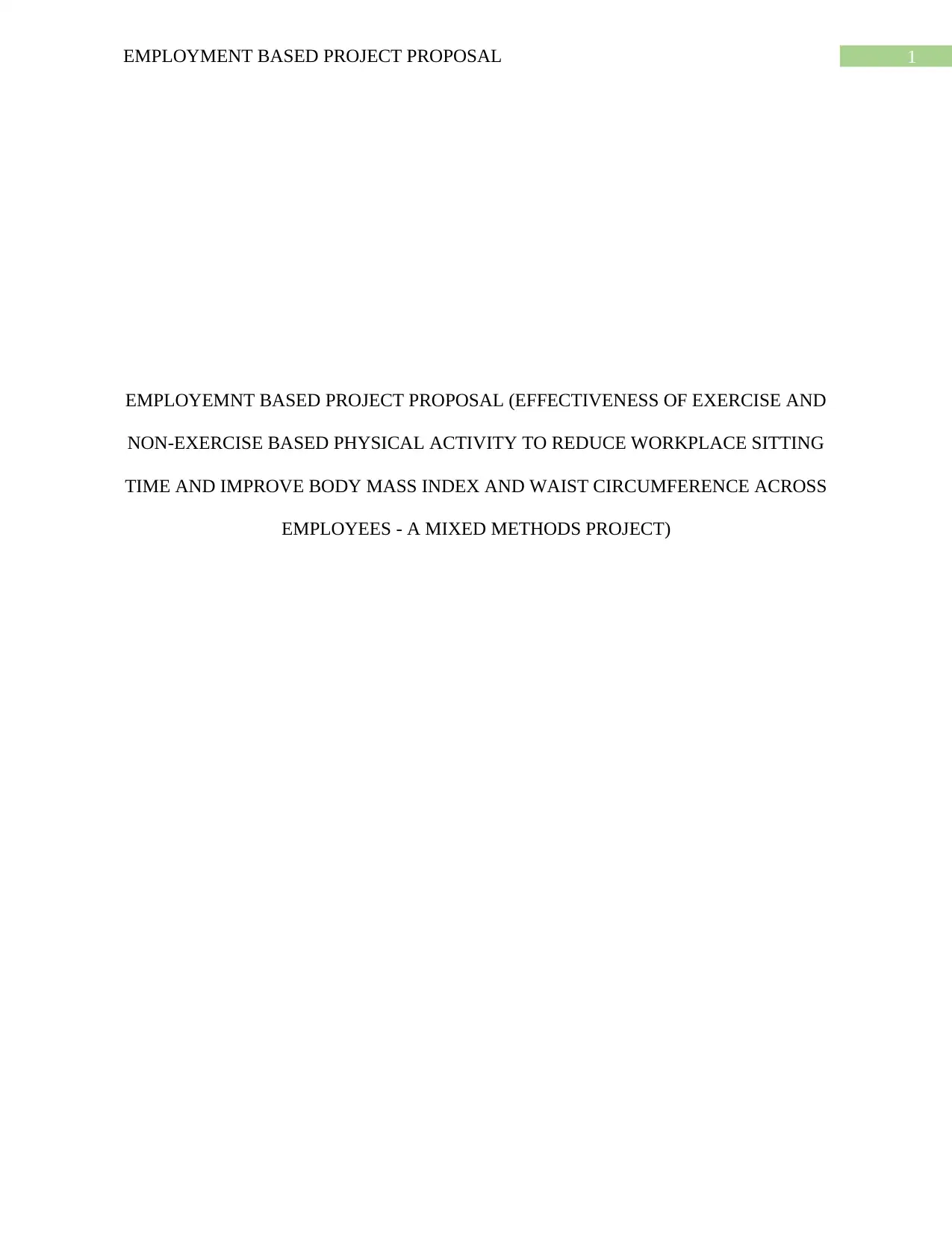
1EMPLOYMENT BASED PROJECT PROPOSAL
EMPLOYEMNT BASED PROJECT PROPOSAL (EFFECTIVENESS OF EXERCISE AND
NON-EXERCISE BASED PHYSICAL ACTIVITY TO REDUCE WORKPLACE SITTING
TIME AND IMPROVE BODY MASS INDEX AND WAIST CIRCUMFERENCE ACROSS
EMPLOYEES - A MIXED METHODS PROJECT)
EMPLOYEMNT BASED PROJECT PROPOSAL (EFFECTIVENESS OF EXERCISE AND
NON-EXERCISE BASED PHYSICAL ACTIVITY TO REDUCE WORKPLACE SITTING
TIME AND IMPROVE BODY MASS INDEX AND WAIST CIRCUMFERENCE ACROSS
EMPLOYEES - A MIXED METHODS PROJECT)
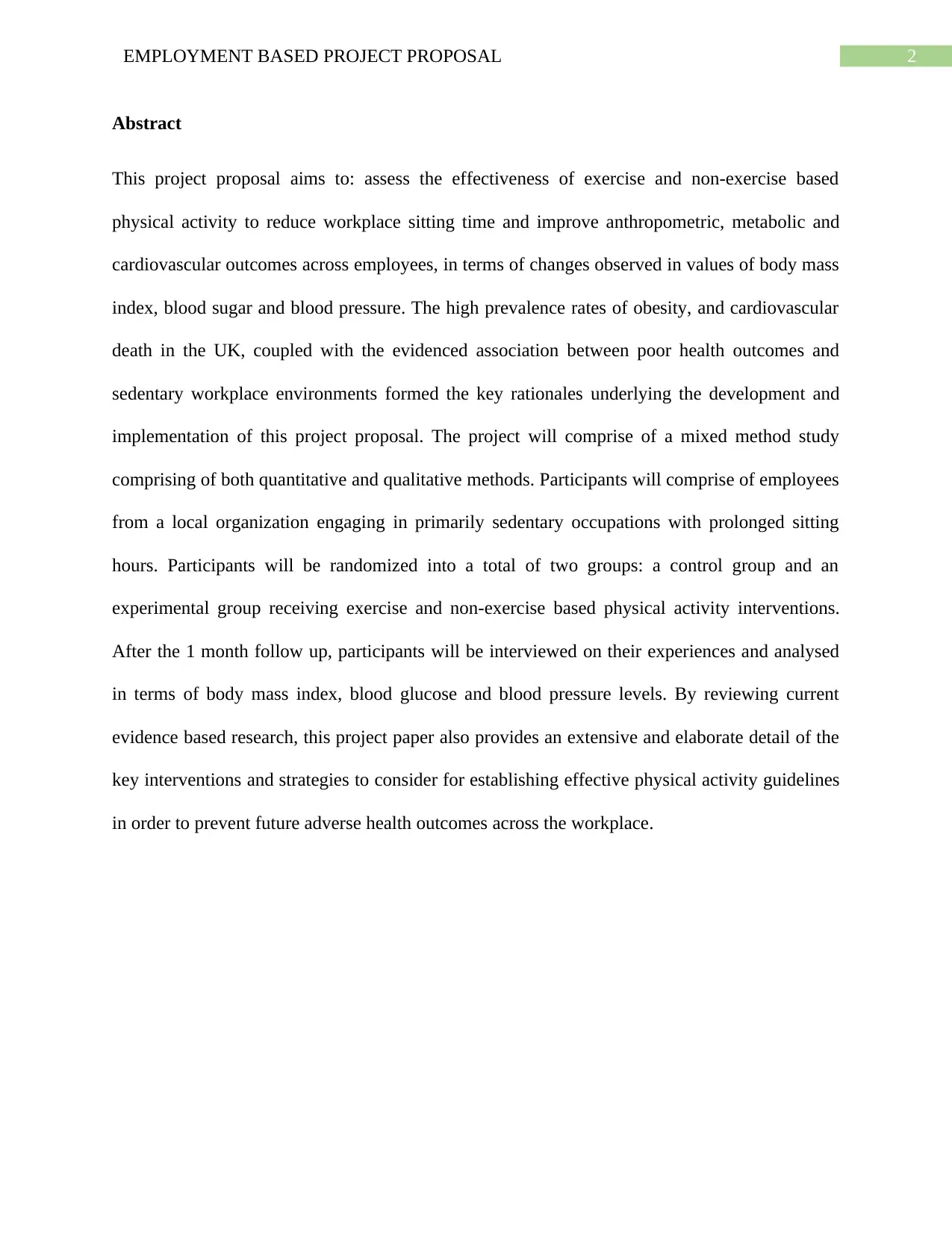
2EMPLOYMENT BASED PROJECT PROPOSAL
Abstract
This project proposal aims to: assess the effectiveness of exercise and non-exercise based
physical activity to reduce workplace sitting time and improve anthropometric, metabolic and
cardiovascular outcomes across employees, in terms of changes observed in values of body mass
index, blood sugar and blood pressure. The high prevalence rates of obesity, and cardiovascular
death in the UK, coupled with the evidenced association between poor health outcomes and
sedentary workplace environments formed the key rationales underlying the development and
implementation of this project proposal. The project will comprise of a mixed method study
comprising of both quantitative and qualitative methods. Participants will comprise of employees
from a local organization engaging in primarily sedentary occupations with prolonged sitting
hours. Participants will be randomized into a total of two groups: a control group and an
experimental group receiving exercise and non-exercise based physical activity interventions.
After the 1 month follow up, participants will be interviewed on their experiences and analysed
in terms of body mass index, blood glucose and blood pressure levels. By reviewing current
evidence based research, this project paper also provides an extensive and elaborate detail of the
key interventions and strategies to consider for establishing effective physical activity guidelines
in order to prevent future adverse health outcomes across the workplace.
Abstract
This project proposal aims to: assess the effectiveness of exercise and non-exercise based
physical activity to reduce workplace sitting time and improve anthropometric, metabolic and
cardiovascular outcomes across employees, in terms of changes observed in values of body mass
index, blood sugar and blood pressure. The high prevalence rates of obesity, and cardiovascular
death in the UK, coupled with the evidenced association between poor health outcomes and
sedentary workplace environments formed the key rationales underlying the development and
implementation of this project proposal. The project will comprise of a mixed method study
comprising of both quantitative and qualitative methods. Participants will comprise of employees
from a local organization engaging in primarily sedentary occupations with prolonged sitting
hours. Participants will be randomized into a total of two groups: a control group and an
experimental group receiving exercise and non-exercise based physical activity interventions.
After the 1 month follow up, participants will be interviewed on their experiences and analysed
in terms of body mass index, blood glucose and blood pressure levels. By reviewing current
evidence based research, this project paper also provides an extensive and elaborate detail of the
key interventions and strategies to consider for establishing effective physical activity guidelines
in order to prevent future adverse health outcomes across the workplace.
⊘ This is a preview!⊘
Do you want full access?
Subscribe today to unlock all pages.

Trusted by 1+ million students worldwide
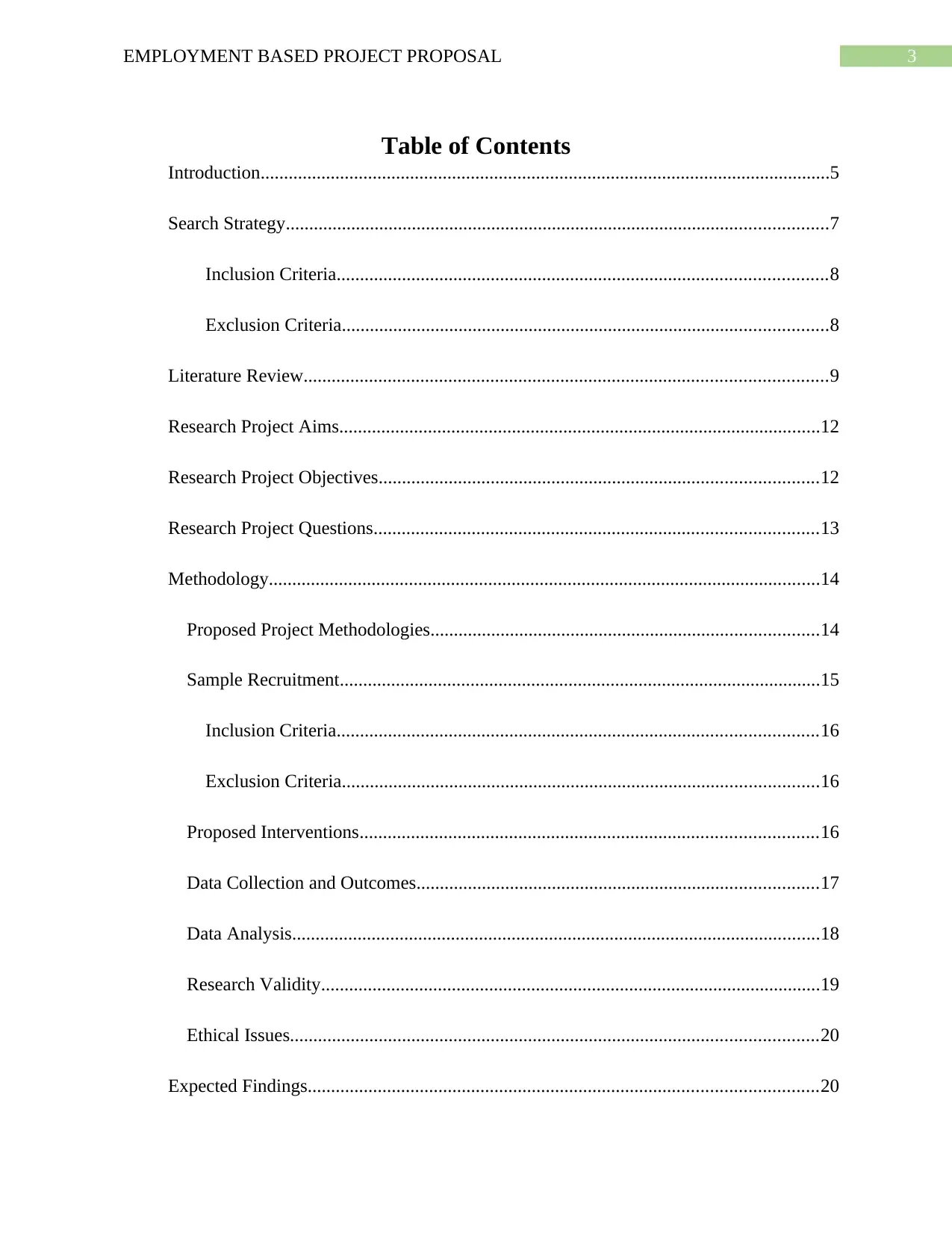
3EMPLOYMENT BASED PROJECT PROPOSAL
Table of Contents
Introduction..........................................................................................................................5
Search Strategy....................................................................................................................7
Inclusion Criteria.........................................................................................................8
Exclusion Criteria........................................................................................................8
Literature Review................................................................................................................9
Research Project Aims.......................................................................................................12
Research Project Objectives..............................................................................................12
Research Project Questions...............................................................................................13
Methodology......................................................................................................................14
Proposed Project Methodologies...................................................................................14
Sample Recruitment.......................................................................................................15
Inclusion Criteria.......................................................................................................16
Exclusion Criteria......................................................................................................16
Proposed Interventions..................................................................................................16
Data Collection and Outcomes......................................................................................17
Data Analysis.................................................................................................................18
Research Validity...........................................................................................................19
Ethical Issues.................................................................................................................20
Expected Findings.............................................................................................................20
Table of Contents
Introduction..........................................................................................................................5
Search Strategy....................................................................................................................7
Inclusion Criteria.........................................................................................................8
Exclusion Criteria........................................................................................................8
Literature Review................................................................................................................9
Research Project Aims.......................................................................................................12
Research Project Objectives..............................................................................................12
Research Project Questions...............................................................................................13
Methodology......................................................................................................................14
Proposed Project Methodologies...................................................................................14
Sample Recruitment.......................................................................................................15
Inclusion Criteria.......................................................................................................16
Exclusion Criteria......................................................................................................16
Proposed Interventions..................................................................................................16
Data Collection and Outcomes......................................................................................17
Data Analysis.................................................................................................................18
Research Validity...........................................................................................................19
Ethical Issues.................................................................................................................20
Expected Findings.............................................................................................................20
Paraphrase This Document
Need a fresh take? Get an instant paraphrase of this document with our AI Paraphraser

4EMPLOYMENT BASED PROJECT PROPOSAL
Recommendations..............................................................................................................21
Conclusion.........................................................................................................................21
References.........................................................................................................................24
Appendix: Gantt Chart.........................................................................................................0
Recommendations..............................................................................................................21
Conclusion.........................................................................................................................21
References.........................................................................................................................24
Appendix: Gantt Chart.........................................................................................................0
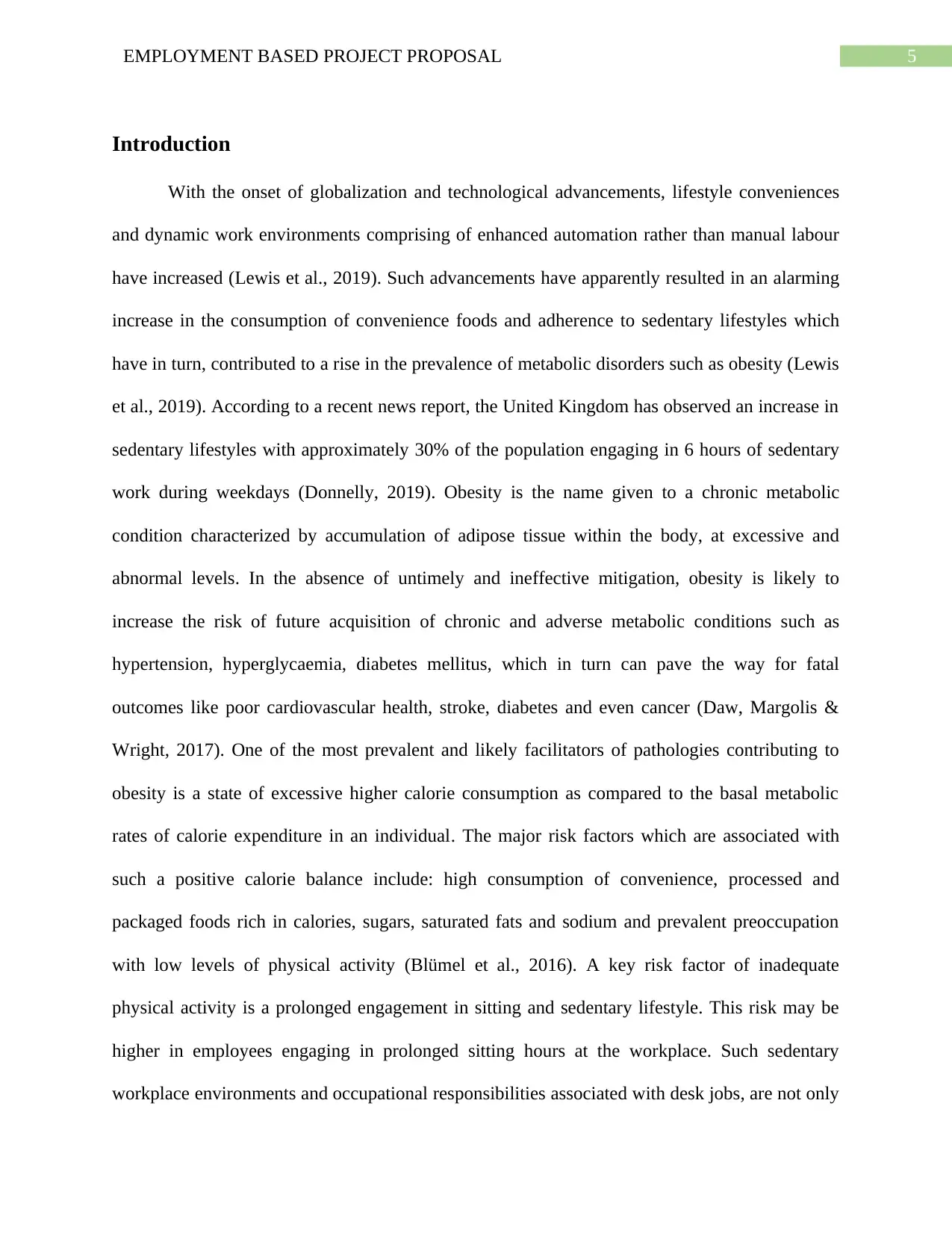
5EMPLOYMENT BASED PROJECT PROPOSAL
Introduction
With the onset of globalization and technological advancements, lifestyle conveniences
and dynamic work environments comprising of enhanced automation rather than manual labour
have increased (Lewis et al., 2019). Such advancements have apparently resulted in an alarming
increase in the consumption of convenience foods and adherence to sedentary lifestyles which
have in turn, contributed to a rise in the prevalence of metabolic disorders such as obesity (Lewis
et al., 2019). According to a recent news report, the United Kingdom has observed an increase in
sedentary lifestyles with approximately 30% of the population engaging in 6 hours of sedentary
work during weekdays (Donnelly, 2019). Obesity is the name given to a chronic metabolic
condition characterized by accumulation of adipose tissue within the body, at excessive and
abnormal levels. In the absence of untimely and ineffective mitigation, obesity is likely to
increase the risk of future acquisition of chronic and adverse metabolic conditions such as
hypertension, hyperglycaemia, diabetes mellitus, which in turn can pave the way for fatal
outcomes like poor cardiovascular health, stroke, diabetes and even cancer (Daw, Margolis &
Wright, 2017). One of the most prevalent and likely facilitators of pathologies contributing to
obesity is a state of excessive higher calorie consumption as compared to the basal metabolic
rates of calorie expenditure in an individual. The major risk factors which are associated with
such a positive calorie balance include: high consumption of convenience, processed and
packaged foods rich in calories, sugars, saturated fats and sodium and prevalent preoccupation
with low levels of physical activity (Blümel et al., 2016). A key risk factor of inadequate
physical activity is a prolonged engagement in sitting and sedentary lifestyle. This risk may be
higher in employees engaging in prolonged sitting hours at the workplace. Such sedentary
workplace environments and occupational responsibilities associated with desk jobs, are not only
Introduction
With the onset of globalization and technological advancements, lifestyle conveniences
and dynamic work environments comprising of enhanced automation rather than manual labour
have increased (Lewis et al., 2019). Such advancements have apparently resulted in an alarming
increase in the consumption of convenience foods and adherence to sedentary lifestyles which
have in turn, contributed to a rise in the prevalence of metabolic disorders such as obesity (Lewis
et al., 2019). According to a recent news report, the United Kingdom has observed an increase in
sedentary lifestyles with approximately 30% of the population engaging in 6 hours of sedentary
work during weekdays (Donnelly, 2019). Obesity is the name given to a chronic metabolic
condition characterized by accumulation of adipose tissue within the body, at excessive and
abnormal levels. In the absence of untimely and ineffective mitigation, obesity is likely to
increase the risk of future acquisition of chronic and adverse metabolic conditions such as
hypertension, hyperglycaemia, diabetes mellitus, which in turn can pave the way for fatal
outcomes like poor cardiovascular health, stroke, diabetes and even cancer (Daw, Margolis &
Wright, 2017). One of the most prevalent and likely facilitators of pathologies contributing to
obesity is a state of excessive higher calorie consumption as compared to the basal metabolic
rates of calorie expenditure in an individual. The major risk factors which are associated with
such a positive calorie balance include: high consumption of convenience, processed and
packaged foods rich in calories, sugars, saturated fats and sodium and prevalent preoccupation
with low levels of physical activity (Blümel et al., 2016). A key risk factor of inadequate
physical activity is a prolonged engagement in sitting and sedentary lifestyle. This risk may be
higher in employees engaging in prolonged sitting hours at the workplace. Such sedentary
workplace environments and occupational responsibilities associated with desk jobs, are not only
⊘ This is a preview!⊘
Do you want full access?
Subscribe today to unlock all pages.

Trusted by 1+ million students worldwide
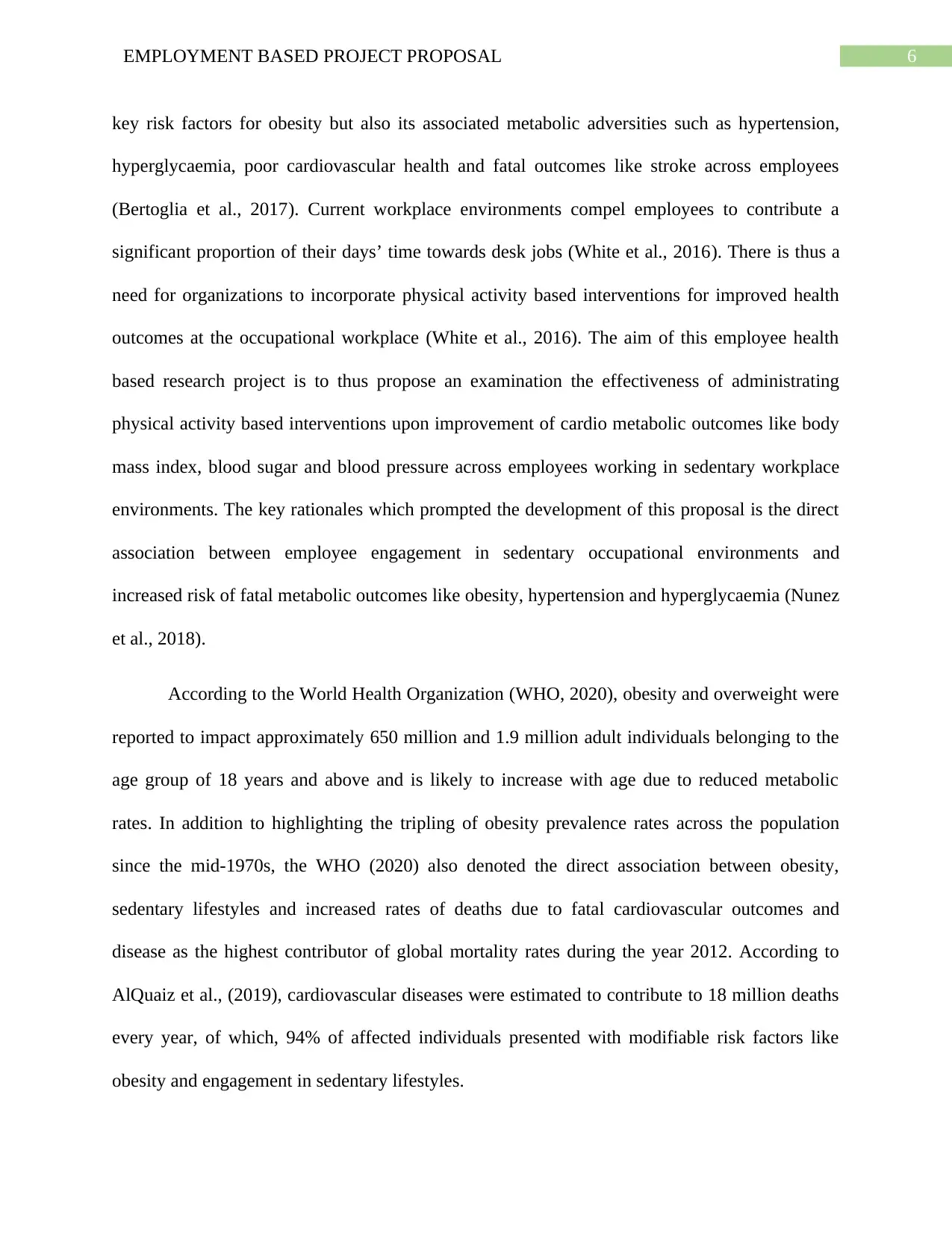
6EMPLOYMENT BASED PROJECT PROPOSAL
key risk factors for obesity but also its associated metabolic adversities such as hypertension,
hyperglycaemia, poor cardiovascular health and fatal outcomes like stroke across employees
(Bertoglia et al., 2017). Current workplace environments compel employees to contribute a
significant proportion of their days’ time towards desk jobs (White et al., 2016). There is thus a
need for organizations to incorporate physical activity based interventions for improved health
outcomes at the occupational workplace (White et al., 2016). The aim of this employee health
based research project is to thus propose an examination the effectiveness of administrating
physical activity based interventions upon improvement of cardio metabolic outcomes like body
mass index, blood sugar and blood pressure across employees working in sedentary workplace
environments. The key rationales which prompted the development of this proposal is the direct
association between employee engagement in sedentary occupational environments and
increased risk of fatal metabolic outcomes like obesity, hypertension and hyperglycaemia (Nunez
et al., 2018).
According to the World Health Organization (WHO, 2020), obesity and overweight were
reported to impact approximately 650 million and 1.9 million adult individuals belonging to the
age group of 18 years and above and is likely to increase with age due to reduced metabolic
rates. In addition to highlighting the tripling of obesity prevalence rates across the population
since the mid-1970s, the WHO (2020) also denoted the direct association between obesity,
sedentary lifestyles and increased rates of deaths due to fatal cardiovascular outcomes and
disease as the highest contributor of global mortality rates during the year 2012. According to
AlQuaiz et al., (2019), cardiovascular diseases were estimated to contribute to 18 million deaths
every year, of which, 94% of affected individuals presented with modifiable risk factors like
obesity and engagement in sedentary lifestyles.
key risk factors for obesity but also its associated metabolic adversities such as hypertension,
hyperglycaemia, poor cardiovascular health and fatal outcomes like stroke across employees
(Bertoglia et al., 2017). Current workplace environments compel employees to contribute a
significant proportion of their days’ time towards desk jobs (White et al., 2016). There is thus a
need for organizations to incorporate physical activity based interventions for improved health
outcomes at the occupational workplace (White et al., 2016). The aim of this employee health
based research project is to thus propose an examination the effectiveness of administrating
physical activity based interventions upon improvement of cardio metabolic outcomes like body
mass index, blood sugar and blood pressure across employees working in sedentary workplace
environments. The key rationales which prompted the development of this proposal is the direct
association between employee engagement in sedentary occupational environments and
increased risk of fatal metabolic outcomes like obesity, hypertension and hyperglycaemia (Nunez
et al., 2018).
According to the World Health Organization (WHO, 2020), obesity and overweight were
reported to impact approximately 650 million and 1.9 million adult individuals belonging to the
age group of 18 years and above and is likely to increase with age due to reduced metabolic
rates. In addition to highlighting the tripling of obesity prevalence rates across the population
since the mid-1970s, the WHO (2020) also denoted the direct association between obesity,
sedentary lifestyles and increased rates of deaths due to fatal cardiovascular outcomes and
disease as the highest contributor of global mortality rates during the year 2012. According to
AlQuaiz et al., (2019), cardiovascular diseases were estimated to contribute to 18 million deaths
every year, of which, 94% of affected individuals presented with modifiable risk factors like
obesity and engagement in sedentary lifestyles.
Paraphrase This Document
Need a fresh take? Get an instant paraphrase of this document with our AI Paraphraser
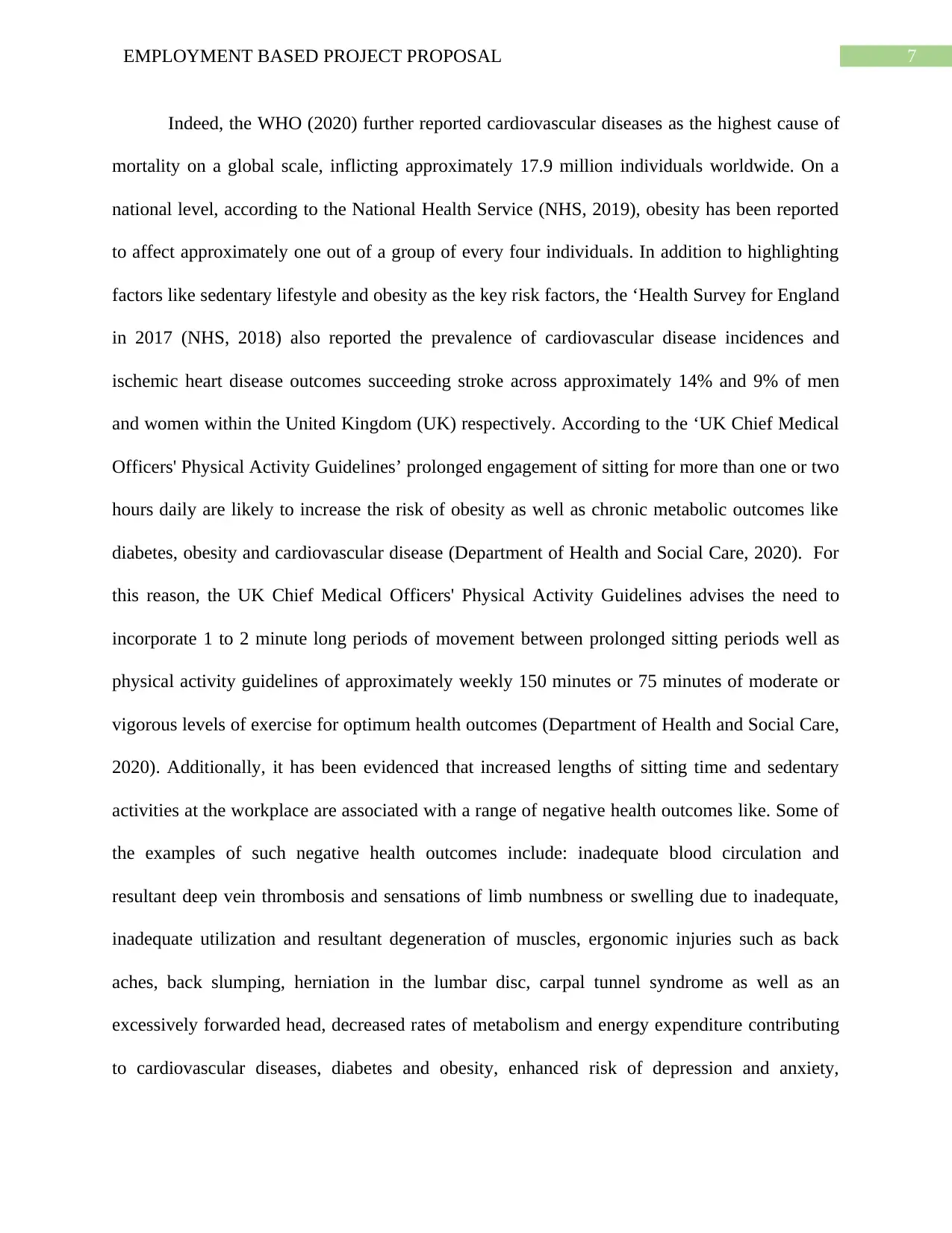
7EMPLOYMENT BASED PROJECT PROPOSAL
Indeed, the WHO (2020) further reported cardiovascular diseases as the highest cause of
mortality on a global scale, inflicting approximately 17.9 million individuals worldwide. On a
national level, according to the National Health Service (NHS, 2019), obesity has been reported
to affect approximately one out of a group of every four individuals. In addition to highlighting
factors like sedentary lifestyle and obesity as the key risk factors, the ‘Health Survey for England
in 2017 (NHS, 2018) also reported the prevalence of cardiovascular disease incidences and
ischemic heart disease outcomes succeeding stroke across approximately 14% and 9% of men
and women within the United Kingdom (UK) respectively. According to the ‘UK Chief Medical
Officers' Physical Activity Guidelines’ prolonged engagement of sitting for more than one or two
hours daily are likely to increase the risk of obesity as well as chronic metabolic outcomes like
diabetes, obesity and cardiovascular disease (Department of Health and Social Care, 2020). For
this reason, the UK Chief Medical Officers' Physical Activity Guidelines advises the need to
incorporate 1 to 2 minute long periods of movement between prolonged sitting periods well as
physical activity guidelines of approximately weekly 150 minutes or 75 minutes of moderate or
vigorous levels of exercise for optimum health outcomes (Department of Health and Social Care,
2020). Additionally, it has been evidenced that increased lengths of sitting time and sedentary
activities at the workplace are associated with a range of negative health outcomes like. Some of
the examples of such negative health outcomes include: inadequate blood circulation and
resultant deep vein thrombosis and sensations of limb numbness or swelling due to inadequate,
inadequate utilization and resultant degeneration of muscles, ergonomic injuries such as back
aches, back slumping, herniation in the lumbar disc, carpal tunnel syndrome as well as an
excessively forwarded head, decreased rates of metabolism and energy expenditure contributing
to cardiovascular diseases, diabetes and obesity, enhanced risk of depression and anxiety,
Indeed, the WHO (2020) further reported cardiovascular diseases as the highest cause of
mortality on a global scale, inflicting approximately 17.9 million individuals worldwide. On a
national level, according to the National Health Service (NHS, 2019), obesity has been reported
to affect approximately one out of a group of every four individuals. In addition to highlighting
factors like sedentary lifestyle and obesity as the key risk factors, the ‘Health Survey for England
in 2017 (NHS, 2018) also reported the prevalence of cardiovascular disease incidences and
ischemic heart disease outcomes succeeding stroke across approximately 14% and 9% of men
and women within the United Kingdom (UK) respectively. According to the ‘UK Chief Medical
Officers' Physical Activity Guidelines’ prolonged engagement of sitting for more than one or two
hours daily are likely to increase the risk of obesity as well as chronic metabolic outcomes like
diabetes, obesity and cardiovascular disease (Department of Health and Social Care, 2020). For
this reason, the UK Chief Medical Officers' Physical Activity Guidelines advises the need to
incorporate 1 to 2 minute long periods of movement between prolonged sitting periods well as
physical activity guidelines of approximately weekly 150 minutes or 75 minutes of moderate or
vigorous levels of exercise for optimum health outcomes (Department of Health and Social Care,
2020). Additionally, it has been evidenced that increased lengths of sitting time and sedentary
activities at the workplace are associated with a range of negative health outcomes like. Some of
the examples of such negative health outcomes include: inadequate blood circulation and
resultant deep vein thrombosis and sensations of limb numbness or swelling due to inadequate,
inadequate utilization and resultant degeneration of muscles, ergonomic injuries such as back
aches, back slumping, herniation in the lumbar disc, carpal tunnel syndrome as well as an
excessively forwarded head, decreased rates of metabolism and energy expenditure contributing
to cardiovascular diseases, diabetes and obesity, enhanced risk of depression and anxiety,
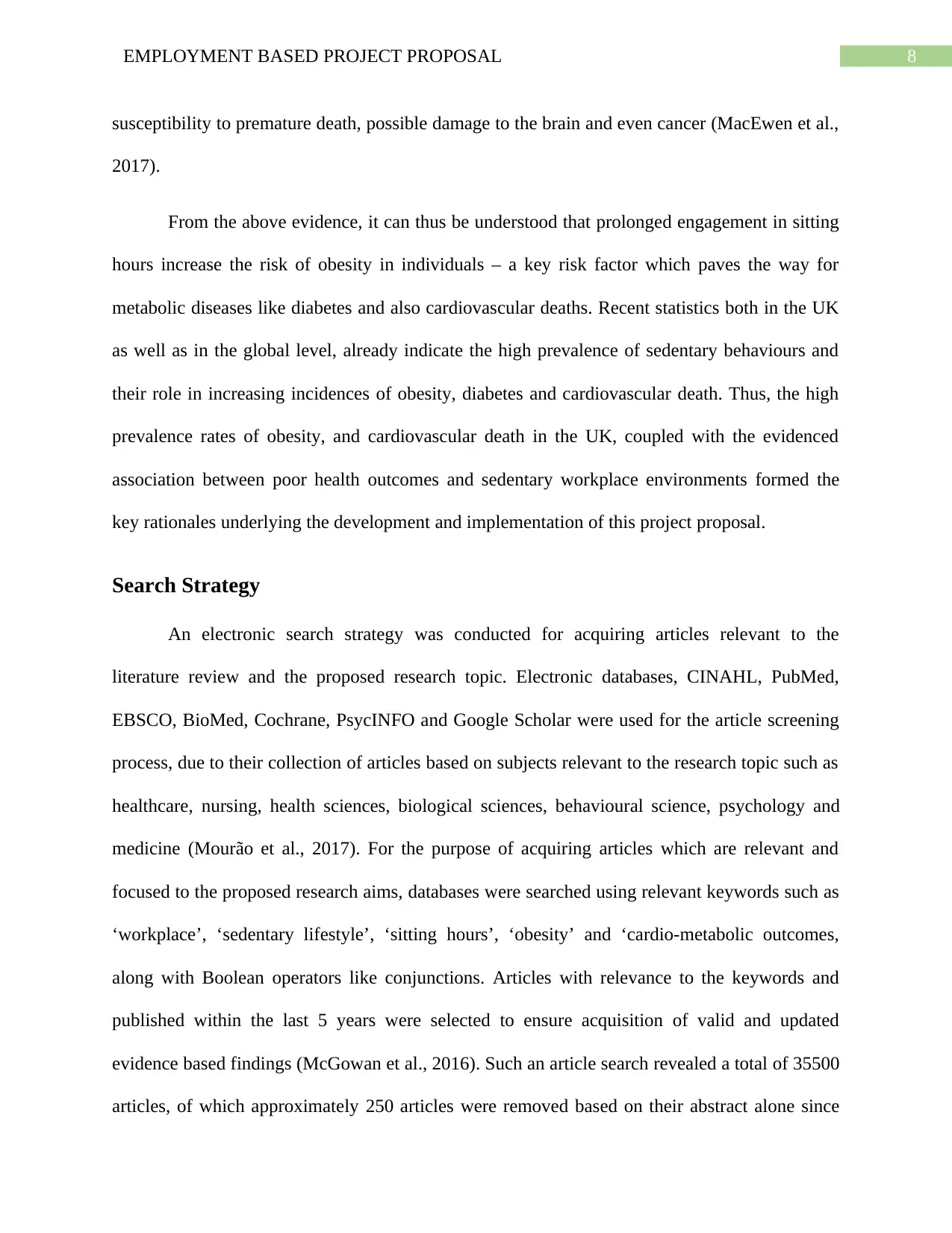
8EMPLOYMENT BASED PROJECT PROPOSAL
susceptibility to premature death, possible damage to the brain and even cancer (MacEwen et al.,
2017).
From the above evidence, it can thus be understood that prolonged engagement in sitting
hours increase the risk of obesity in individuals – a key risk factor which paves the way for
metabolic diseases like diabetes and also cardiovascular deaths. Recent statistics both in the UK
as well as in the global level, already indicate the high prevalence of sedentary behaviours and
their role in increasing incidences of obesity, diabetes and cardiovascular death. Thus, the high
prevalence rates of obesity, and cardiovascular death in the UK, coupled with the evidenced
association between poor health outcomes and sedentary workplace environments formed the
key rationales underlying the development and implementation of this project proposal.
Search Strategy
An electronic search strategy was conducted for acquiring articles relevant to the
literature review and the proposed research topic. Electronic databases, CINAHL, PubMed,
EBSCO, BioMed, Cochrane, PsycINFO and Google Scholar were used for the article screening
process, due to their collection of articles based on subjects relevant to the research topic such as
healthcare, nursing, health sciences, biological sciences, behavioural science, psychology and
medicine (Mourão et al., 2017). For the purpose of acquiring articles which are relevant and
focused to the proposed research aims, databases were searched using relevant keywords such as
‘workplace’, ‘sedentary lifestyle’, ‘sitting hours’, ‘obesity’ and ‘cardio-metabolic outcomes,
along with Boolean operators like conjunctions. Articles with relevance to the keywords and
published within the last 5 years were selected to ensure acquisition of valid and updated
evidence based findings (McGowan et al., 2016). Such an article search revealed a total of 35500
articles, of which approximately 250 articles were removed based on their abstract alone since
susceptibility to premature death, possible damage to the brain and even cancer (MacEwen et al.,
2017).
From the above evidence, it can thus be understood that prolonged engagement in sitting
hours increase the risk of obesity in individuals – a key risk factor which paves the way for
metabolic diseases like diabetes and also cardiovascular deaths. Recent statistics both in the UK
as well as in the global level, already indicate the high prevalence of sedentary behaviours and
their role in increasing incidences of obesity, diabetes and cardiovascular death. Thus, the high
prevalence rates of obesity, and cardiovascular death in the UK, coupled with the evidenced
association between poor health outcomes and sedentary workplace environments formed the
key rationales underlying the development and implementation of this project proposal.
Search Strategy
An electronic search strategy was conducted for acquiring articles relevant to the
literature review and the proposed research topic. Electronic databases, CINAHL, PubMed,
EBSCO, BioMed, Cochrane, PsycINFO and Google Scholar were used for the article screening
process, due to their collection of articles based on subjects relevant to the research topic such as
healthcare, nursing, health sciences, biological sciences, behavioural science, psychology and
medicine (Mourão et al., 2017). For the purpose of acquiring articles which are relevant and
focused to the proposed research aims, databases were searched using relevant keywords such as
‘workplace’, ‘sedentary lifestyle’, ‘sitting hours’, ‘obesity’ and ‘cardio-metabolic outcomes,
along with Boolean operators like conjunctions. Articles with relevance to the keywords and
published within the last 5 years were selected to ensure acquisition of valid and updated
evidence based findings (McGowan et al., 2016). Such an article search revealed a total of 35500
articles, of which approximately 250 articles were removed based on their abstract alone since
⊘ This is a preview!⊘
Do you want full access?
Subscribe today to unlock all pages.

Trusted by 1+ million students worldwide
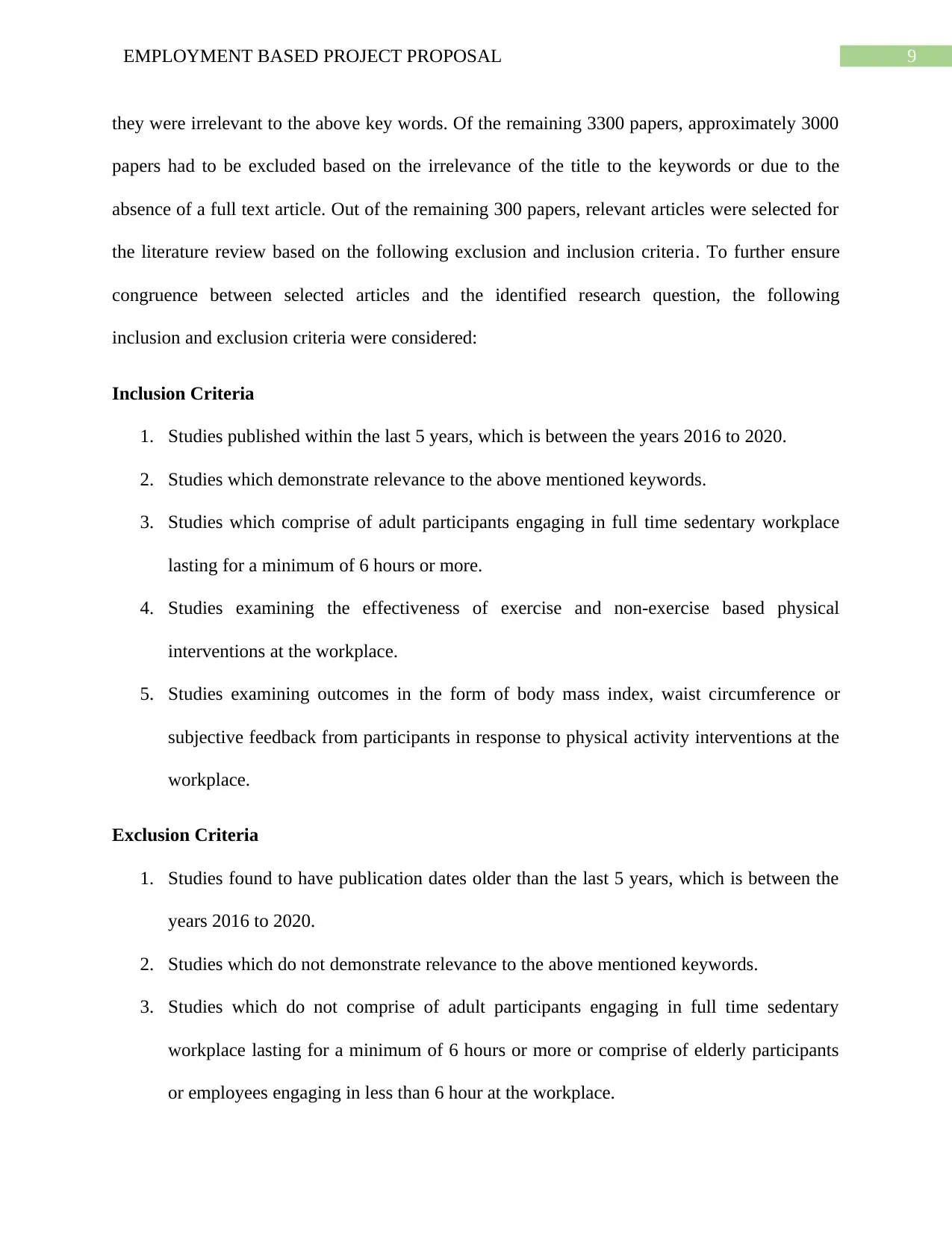
9EMPLOYMENT BASED PROJECT PROPOSAL
they were irrelevant to the above key words. Of the remaining 3300 papers, approximately 3000
papers had to be excluded based on the irrelevance of the title to the keywords or due to the
absence of a full text article. Out of the remaining 300 papers, relevant articles were selected for
the literature review based on the following exclusion and inclusion criteria. To further ensure
congruence between selected articles and the identified research question, the following
inclusion and exclusion criteria were considered:
Inclusion Criteria
1. Studies published within the last 5 years, which is between the years 2016 to 2020.
2. Studies which demonstrate relevance to the above mentioned keywords.
3. Studies which comprise of adult participants engaging in full time sedentary workplace
lasting for a minimum of 6 hours or more.
4. Studies examining the effectiveness of exercise and non-exercise based physical
interventions at the workplace.
5. Studies examining outcomes in the form of body mass index, waist circumference or
subjective feedback from participants in response to physical activity interventions at the
workplace.
Exclusion Criteria
1. Studies found to have publication dates older than the last 5 years, which is between the
years 2016 to 2020.
2. Studies which do not demonstrate relevance to the above mentioned keywords.
3. Studies which do not comprise of adult participants engaging in full time sedentary
workplace lasting for a minimum of 6 hours or more or comprise of elderly participants
or employees engaging in less than 6 hour at the workplace.
they were irrelevant to the above key words. Of the remaining 3300 papers, approximately 3000
papers had to be excluded based on the irrelevance of the title to the keywords or due to the
absence of a full text article. Out of the remaining 300 papers, relevant articles were selected for
the literature review based on the following exclusion and inclusion criteria. To further ensure
congruence between selected articles and the identified research question, the following
inclusion and exclusion criteria were considered:
Inclusion Criteria
1. Studies published within the last 5 years, which is between the years 2016 to 2020.
2. Studies which demonstrate relevance to the above mentioned keywords.
3. Studies which comprise of adult participants engaging in full time sedentary workplace
lasting for a minimum of 6 hours or more.
4. Studies examining the effectiveness of exercise and non-exercise based physical
interventions at the workplace.
5. Studies examining outcomes in the form of body mass index, waist circumference or
subjective feedback from participants in response to physical activity interventions at the
workplace.
Exclusion Criteria
1. Studies found to have publication dates older than the last 5 years, which is between the
years 2016 to 2020.
2. Studies which do not demonstrate relevance to the above mentioned keywords.
3. Studies which do not comprise of adult participants engaging in full time sedentary
workplace lasting for a minimum of 6 hours or more or comprise of elderly participants
or employees engaging in less than 6 hour at the workplace.
Paraphrase This Document
Need a fresh take? Get an instant paraphrase of this document with our AI Paraphraser
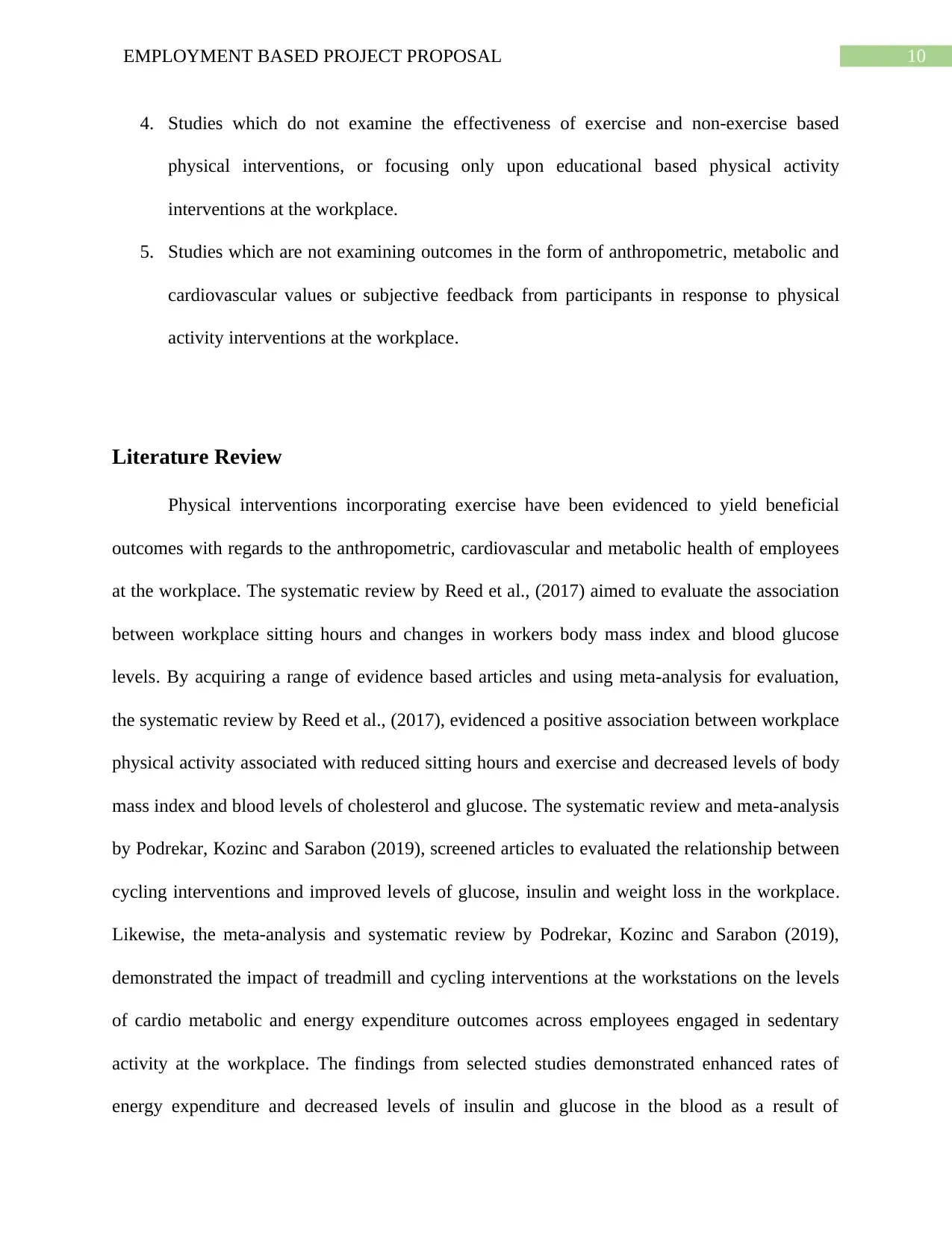
10EMPLOYMENT BASED PROJECT PROPOSAL
4. Studies which do not examine the effectiveness of exercise and non-exercise based
physical interventions, or focusing only upon educational based physical activity
interventions at the workplace.
5. Studies which are not examining outcomes in the form of anthropometric, metabolic and
cardiovascular values or subjective feedback from participants in response to physical
activity interventions at the workplace.
Literature Review
Physical interventions incorporating exercise have been evidenced to yield beneficial
outcomes with regards to the anthropometric, cardiovascular and metabolic health of employees
at the workplace. The systematic review by Reed et al., (2017) aimed to evaluate the association
between workplace sitting hours and changes in workers body mass index and blood glucose
levels. By acquiring a range of evidence based articles and using meta-analysis for evaluation,
the systematic review by Reed et al., (2017), evidenced a positive association between workplace
physical activity associated with reduced sitting hours and exercise and decreased levels of body
mass index and blood levels of cholesterol and glucose. The systematic review and meta-analysis
by Podrekar, Kozinc and Sarabon (2019), screened articles to evaluated the relationship between
cycling interventions and improved levels of glucose, insulin and weight loss in the workplace.
Likewise, the meta-analysis and systematic review by Podrekar, Kozinc and Sarabon (2019),
demonstrated the impact of treadmill and cycling interventions at the workstations on the levels
of cardio metabolic and energy expenditure outcomes across employees engaged in sedentary
activity at the workplace. The findings from selected studies demonstrated enhanced rates of
energy expenditure and decreased levels of insulin and glucose in the blood as a result of
4. Studies which do not examine the effectiveness of exercise and non-exercise based
physical interventions, or focusing only upon educational based physical activity
interventions at the workplace.
5. Studies which are not examining outcomes in the form of anthropometric, metabolic and
cardiovascular values or subjective feedback from participants in response to physical
activity interventions at the workplace.
Literature Review
Physical interventions incorporating exercise have been evidenced to yield beneficial
outcomes with regards to the anthropometric, cardiovascular and metabolic health of employees
at the workplace. The systematic review by Reed et al., (2017) aimed to evaluate the association
between workplace sitting hours and changes in workers body mass index and blood glucose
levels. By acquiring a range of evidence based articles and using meta-analysis for evaluation,
the systematic review by Reed et al., (2017), evidenced a positive association between workplace
physical activity associated with reduced sitting hours and exercise and decreased levels of body
mass index and blood levels of cholesterol and glucose. The systematic review and meta-analysis
by Podrekar, Kozinc and Sarabon (2019), screened articles to evaluated the relationship between
cycling interventions and improved levels of glucose, insulin and weight loss in the workplace.
Likewise, the meta-analysis and systematic review by Podrekar, Kozinc and Sarabon (2019),
demonstrated the impact of treadmill and cycling interventions at the workstations on the levels
of cardio metabolic and energy expenditure outcomes across employees engaged in sedentary
activity at the workplace. The findings from selected studies demonstrated enhanced rates of
energy expenditure and decreased levels of insulin and glucose in the blood as a result of
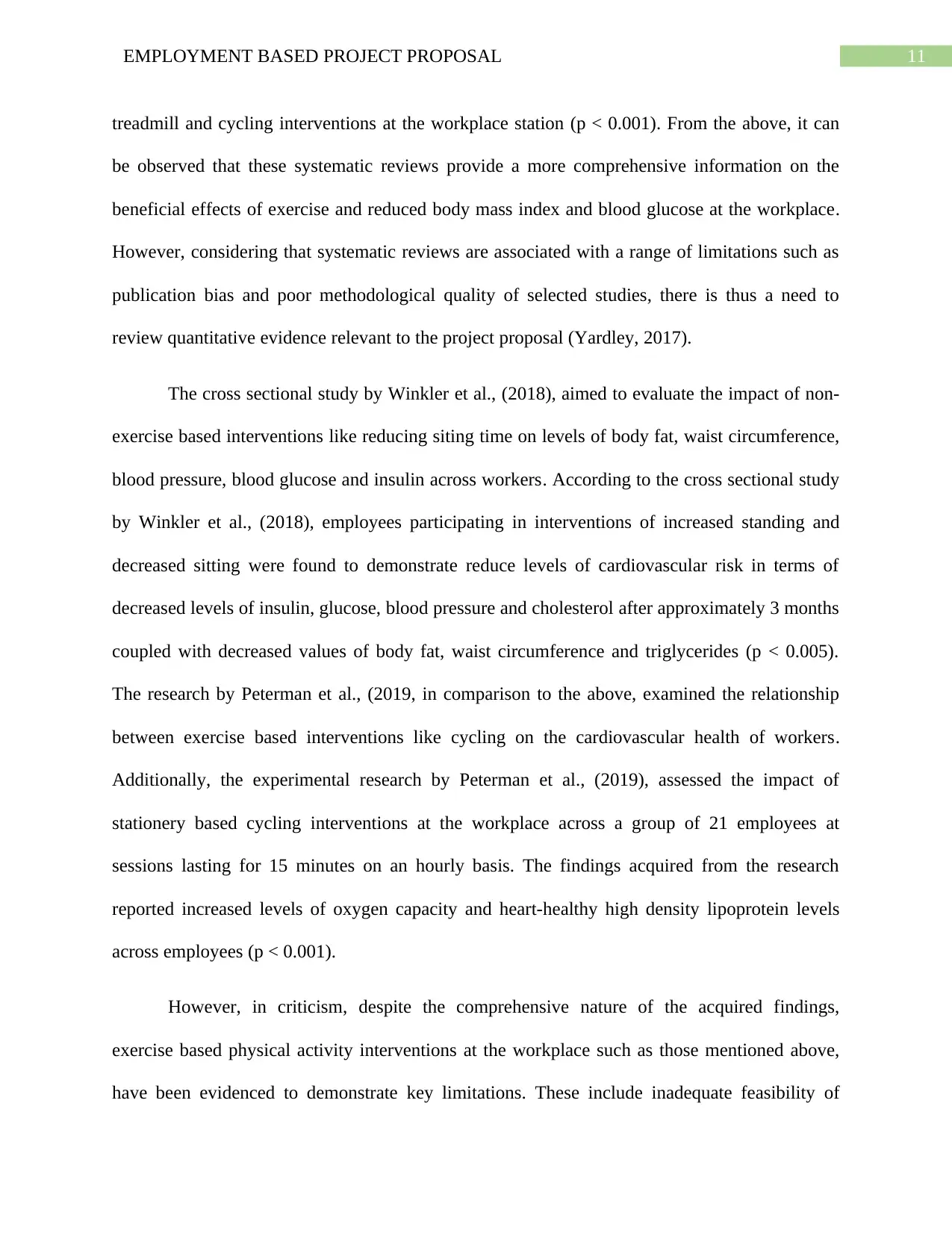
11EMPLOYMENT BASED PROJECT PROPOSAL
treadmill and cycling interventions at the workplace station (p < 0.001). From the above, it can
be observed that these systematic reviews provide a more comprehensive information on the
beneficial effects of exercise and reduced body mass index and blood glucose at the workplace.
However, considering that systematic reviews are associated with a range of limitations such as
publication bias and poor methodological quality of selected studies, there is thus a need to
review quantitative evidence relevant to the project proposal (Yardley, 2017).
The cross sectional study by Winkler et al., (2018), aimed to evaluate the impact of non-
exercise based interventions like reducing siting time on levels of body fat, waist circumference,
blood pressure, blood glucose and insulin across workers. According to the cross sectional study
by Winkler et al., (2018), employees participating in interventions of increased standing and
decreased sitting were found to demonstrate reduce levels of cardiovascular risk in terms of
decreased levels of insulin, glucose, blood pressure and cholesterol after approximately 3 months
coupled with decreased values of body fat, waist circumference and triglycerides (p < 0.005).
The research by Peterman et al., (2019, in comparison to the above, examined the relationship
between exercise based interventions like cycling on the cardiovascular health of workers.
Additionally, the experimental research by Peterman et al., (2019), assessed the impact of
stationery based cycling interventions at the workplace across a group of 21 employees at
sessions lasting for 15 minutes on an hourly basis. The findings acquired from the research
reported increased levels of oxygen capacity and heart-healthy high density lipoprotein levels
across employees (p < 0.001).
However, in criticism, despite the comprehensive nature of the acquired findings,
exercise based physical activity interventions at the workplace such as those mentioned above,
have been evidenced to demonstrate key limitations. These include inadequate feasibility of
treadmill and cycling interventions at the workplace station (p < 0.001). From the above, it can
be observed that these systematic reviews provide a more comprehensive information on the
beneficial effects of exercise and reduced body mass index and blood glucose at the workplace.
However, considering that systematic reviews are associated with a range of limitations such as
publication bias and poor methodological quality of selected studies, there is thus a need to
review quantitative evidence relevant to the project proposal (Yardley, 2017).
The cross sectional study by Winkler et al., (2018), aimed to evaluate the impact of non-
exercise based interventions like reducing siting time on levels of body fat, waist circumference,
blood pressure, blood glucose and insulin across workers. According to the cross sectional study
by Winkler et al., (2018), employees participating in interventions of increased standing and
decreased sitting were found to demonstrate reduce levels of cardiovascular risk in terms of
decreased levels of insulin, glucose, blood pressure and cholesterol after approximately 3 months
coupled with decreased values of body fat, waist circumference and triglycerides (p < 0.005).
The research by Peterman et al., (2019, in comparison to the above, examined the relationship
between exercise based interventions like cycling on the cardiovascular health of workers.
Additionally, the experimental research by Peterman et al., (2019), assessed the impact of
stationery based cycling interventions at the workplace across a group of 21 employees at
sessions lasting for 15 minutes on an hourly basis. The findings acquired from the research
reported increased levels of oxygen capacity and heart-healthy high density lipoprotein levels
across employees (p < 0.001).
However, in criticism, despite the comprehensive nature of the acquired findings,
exercise based physical activity interventions at the workplace such as those mentioned above,
have been evidenced to demonstrate key limitations. These include inadequate feasibility of
⊘ This is a preview!⊘
Do you want full access?
Subscribe today to unlock all pages.

Trusted by 1+ million students worldwide
1 out of 34
Related Documents
Your All-in-One AI-Powered Toolkit for Academic Success.
+13062052269
info@desklib.com
Available 24*7 on WhatsApp / Email
![[object Object]](/_next/static/media/star-bottom.7253800d.svg)
Unlock your academic potential
Copyright © 2020–2025 A2Z Services. All Rights Reserved. Developed and managed by ZUCOL.





